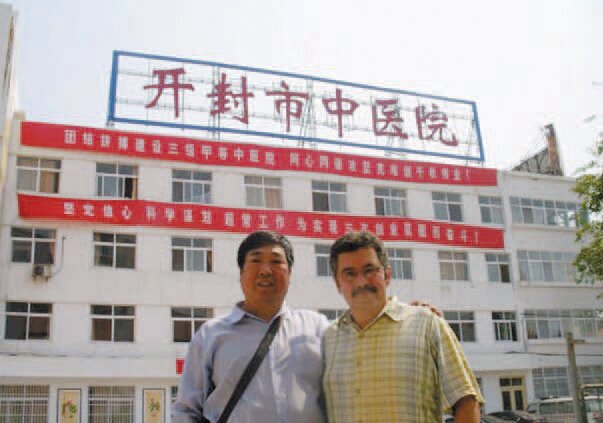Warning: Parameter 1 to plgContentLoginToRead::onAfterDisplayTitle() expected to be a reference, value given in /home/joomla789/domains/jewishtimesasia.org/public_html/libraries/joomla/event/event.php on line 67
| A personal visit to Kaifeng, China in 2009 |

|

|
|
I travelled to China this past spring as President of the Sino- Judaic Institute primarily to assess firsthand the status of the Kaifeng Jewish descendants through an extended stay there.
Thirty-five years ago, when I was a student on the first Canada- China Student Exchange Programme, I had tried to visit Kaifeng but was told it was a “closed cityâ€. By contrast, today the city is accessible and it is easy to meet people. I meet my travel guide, Shi Lei, and his father (both Jewish descendants) to take a cab to the old Jewish quarter. There is a new stone marker on the main street, in Chinese, telling everyone the historical nature of the place.
First we see the site of the synagogue—now a hospital. We pose for pictures. Then we wander around back, through a back alley, to view the one part of the synagogue still standing— its well—literally a hole in the ground! The Shis struggle to lift up the lid and Shi Lei asks if I want to take a picture. “Of what?†I ask myself. “A hole in the ground?†There isn’t even a sign to mark its historical significance. We walk a short way to the old Jewish street—South Teaching Torah Lane. It’s not much to look at—like a back alley that’s not even paved. Prof. Xu Xin, of Nanjing U, has put up some signs in Chinese, Hebrew and English. Meeting the Zhao family We wind our way to the house of the Zhao family—the only one still on site. The house has two rooms. One has a bed, desk and table for four. This is also the Zhao family museum. The other room has two beds and a kitchenette. It is clean but a little grim. Later, it occurs to me that these Jewish descendants are proud of all that they have, even if it is an unmarked well and two-room house on an old hutong—and I am both ashamed of my judgmental behaviour and proud of them for hanging on to so little for so long. Old Mrs. Zhao is 84 and looks 94. I ask her if she remembers her husband doing any Jewish things. (She isn’t Jewish—Kaifeng Jews trace lineage through the male lineage.) She doesn’t remember anything but just then her granddaughter, Guo Yan, comes in. She speaks perfect English but has never left China. She runs the museum and maintains a website. She shows us her nearby room, which has the Sh’ma carved in gold letters on black wood. She recites it for us. She wants to build a museum/centre on site. I learn about the Jewish school she attends several evenings a week. Shi Lei museum We hop a cab to visit the Shi family museum. You begin to see the problem: two families, two museums. Here four homes are clustered around an inner courtyard. One house (two rooms) houses the museum and nothing else. It consists of photos, a few artifacts and gifts from foreign Jewish visitors. Some of the photos are quite historical and never been published before. After talking for about an hour or more, we return to the hotel. On the way in, one of the women picketing at the hotel site recognises Shi Lei and calls out to him. We go over and, guess what—another Kaifeng Jew. “Shalomâ€, she says to me. “Ani Yehudi m’Kaifeng.†She learned her Hebrew here in Kaifeng.
I couldn’t believe it—both the coincidence of meeting another Jew in Kaifeng and her being able to speak some Hebrew! First stop today is the Song Dynasty theme park in order to see Sino-Judaic Institute’s exhibit on the Kaifeng Jews and tour the park. Just as I had been told, the exhibit is only available on a need-to-see basis—which means it is only unlocked for foreign guests. A young woman in Song dynasty dress welcomes us and we look around the three rooms. A Chinese man wanders in and Shi Lei says if it’s open, it should be open to all. The exhibit is not too bad. I ask him, if it is only open to foreigners, then why are the signs also in Chinese and, if they want to make money, why don’t they let Chinese tourists see this too? He doesn’t have any answers of course. Tomorrow I am going to meet his company’s manager and ask her these questions. It doesn’t make any sense to me at all. That afternoon, Shi Lei and I go on the Municipal Museum, which houses the famous Jewish steles. As we approach, Shi Lei notes that the museum has had both an external and an internal facelift. Shi Lei speaks to the attendant and we are escorted up three flights of stairs to a narrow, locked double door. We go up another flight of stairs. Another foreigner, a university student, follows us but is told she can’t come up. “Why?†she asks. “It is private. You can’t come up.†She leaves. The attendant goes up and then unlocks a gate grill to let us in. The exhibit is nicely displayed but small. There are two illegible steles and a big stone bowl about a meter across, with lotus flowers carved on its sides. There are rubbings of the steles done in 1926 that show what they used to say and a map of Jewish Asia from the land of Israel to China. God knows why the exhibit is double locked— it’s not as if there is anything either controversial or even portable up here. I think how wonderful it would be if Kaifeng had just one exhibit on its Jewish community that was as well done and as accessible as Lord Bao’s temple is. Shi Lei took me to meet his boss because her travel agency handles most of the foreign Jewish tours to Kaifeng. I point out that other Chinese are Kaifeng’s biggest tourist market but that the existence of the Jewish community is almost a secret. Kaifeng and China should be proud of how they treated the Jews and let its citizens and the world know about this. We returned to the hotel and I prepared myself for the main event: the meeting with the descendants. At 6:30 I went downstairs to the meeting room and started to welcome individuals as they came in. When everyone was settled in—including a young Israeli student who teaches some of the descendents several times a week—I introduced myself in my very best Chinese. When I said how happy I was to finally be here with them in Kaifeng on Erev Shabbat, they all clapped enthusiastically. Very respectfully I offered them several suggestions: There are four mediocre exhibits on Kaifeng Jews. Perhaps it would be good to try to get them combined into one site with a compelling exhibit like that of Lord Bao at his memorial temple. Murmurs all around. They are their own greatest resource. Other Jews will recommend Kaifeng as a tourist destination if they meet descendants, talk with them, and be inspired by their dedication to their heritage. The best thing the descendants can do is to keep studying. Showing collective initiative could open doors for young people to visit and study in Israel— Shi Lei is a good example of what is possible. Then I sat down and waited for comments. Many of those present attend the “Yiceleye (Israel) schoolâ€; but several go to Shi Lei’s classes. Some do nothing. Only members of the Li, Shi, Ai and Zhao families were present. They said the Zhang family had disappeared long ago. No Jins attended but they’re around—some had made aliyah and one, a former school leader, is in bad favor with everyone. Finally a woman sitting at the opposite end of the table spoke up: “We have heard this before from others. They come and make promises and nothing happens. “But we already have a school here for the descendants in a place funded by Hong Kong Christians. They don’t want to convert us. In fact, they want to become Jews. (Everyone laughs.) Their motives are good. “I am 67 years and now I am studying Hebrew. We study and observe Shabbat together and holidays with potluck dinners. In fact ours is waiting now. “We don’t have enough money to rent a place big enough for observance and study. We need a synagogue for cohesion of our community.†Other people chimed in that they want to send their young to Israel to study, that the school is their organisation, that young people may need help financially to attend college, that other Jews (not Christians) should assist them. Then a stocky young man spoke. He said the descendants know their history and proceeded to give me a précis. He said that there could be 2000 descendents in Kaifeng even though they have been isolated for a long time. He said other Jews have no idea how powerful an influence Han culture is. It has assimilated many other—and—larger, minorities. But not its Jews! He said the reason was that they had a synagogue and that they knew their ancestors stretched back to Abraham. “We need a synagogue again,†he exclaimed. “We want our strong voice to be heard by world Jewry and to be helped. We’ve been here 1000 years and world Jewry shouldn’t abandon us.†I responded that I would do my best to get their message out. I suggested that we would not be able to build a synagogue but perhaps they could rent a bigger space since Jews can pray in any building. Heads nodded. I also said we don’t want to run their affairs, only to help them help themselves (which it sounds like they are doing). I also pointed out that today our world is smaller and that we have email and websites and cell phones to communicate more easily. Everyone applauded. I thanked everyone for coming and wished them “Shabbat Shalomâ€. “Shabbat Shalom†they shouted back. I was bowled over. I felt great—until a number of Shi Lei’s students asked to meet with me. One man, a Li family member, said we shouldn’t give money only to that school, claimed that its members had been baptized, that the leadership should include representatives from all the clans. This kind of criticism was what I had been told to expect. I said: “I wish you had spoken up about some of these things at the meeting.†“Well I didn’t want to embarrass other family members.†(I then realized that the Chinese do meetings Japanese style—resolve issues first so that formal meetings proceed without incident.) The next day, I was supposed to go sightseeing but because of rain we decided to meet instead with Mr. Li again, who wanted very much to speak with me. However, instead of just Mr. Li, 8 people crowded into my little hotel room for a 2½ hour chat. There were members of the Li, Ai and Shi families. They talked with concern about the other group (it had been taught by a messianic Jew and some Hong Kong Christians pay for their school room) and they worried about their being led astray. The Shi faction is strongly against any Christian influence or participation. They also claim that the other school is more popular because people hope that it will enable them to visit Israel or make aliyah. On Monday evening, Shi Lei and I went off to the Yiceleye school. The school is a oneroom office in a small office compound with other businesses all around. Inside is an Israeli flag on one wall and on the wall facing is a calligraphy saying “Yi Ce Le Yeâ€, pictures of descendents old and new, and the Ten Commandments in Chinese. Opposite the door is a bookcase and a computer. Behind the bookcase is a small kitchen area and a toilet. I didn’t see any sign of anything Christian, either in the bookcase or in any of the study materials. (Recently several religiously observant Jews from Israel, including a rabbi, met and “examined†members of this group about their beliefs and also found no evidence of Christian theology.) After sitting though one and a half hours of beginners Hebrew in an airless room, we got to talk. We discussed the need to create a census or roster of community members. Once they had “Jew†on their local identity cards but no longer—they are forced to choose between “Han†or “Huiâ€. It is clear that there is no chance of a meeting of minds between the two factions in the near future. One young man suggests that the other group be invited to visit and participate and then, over time, merger discussions could begin. That seems to be the consensus for now. I am disappointed but not surprised. Returning back home After I returned home to Seattle, I shared the following plan both with the Sino-Judaic Institute’s Board and with representatives of both groups in Kaifeng: • Economically and in terms of available teachers, it makes sense to have one school but this may take time or it may never happen. Ultimately it is their choice to make and it all depends on them. • Although it would be best to have one school, there is no reason why there can’t be two schools/groups. Every Jewish community has its divisions— why should Kaifeng be any different? • Even with two schools, the descendants will still need some kind of overall organisation that represents all (or most) of them as a community in order to relate to local, provincial or national authorities; to determine who should meet with foreign guests, etc. • Their idea to elect 10 people to form such a communal organisation is a good one: 2 from each clan/5 from each school. These representatives would work together for the good of both schools and uninvolved people too. Sino-Judaic Institute (SJI), intends to support each school equally but will set aside a larger amount if the two groups actually succeed in forming this proposed community organisation. Besides having liaisons with each group, SJI will make a point of having someone from its Board make an annual visit to Kaifeng. Time will tell whether or not the Jewish descendants in Kaifeng will be able to surmount their differences and find common cause with one another, or if their divisions will persist and they will remain weak and in conflict. Supplied by Rabbi Anson Laytner (Issue November 2009)
|

















